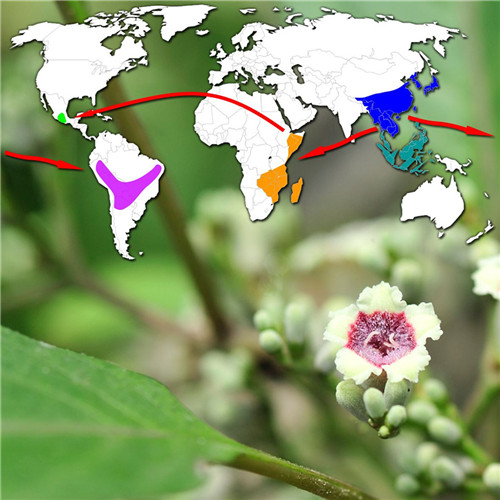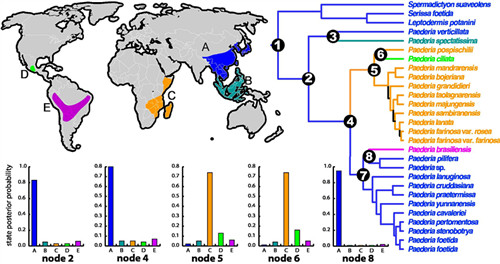Pantropical disjunctions usually involve tropical regions of the Americas, Africa, south-eastern Asia and Australia. Studies of the origin and diversification of tropical intercontinental disjunctions in plants may provide important insights into the evolutionary assembly of tropical forests. However, most studies have focused on the family level, and only a few groups have been examined at the generic level with molecular phylogenetic and biogeographical methods. Paederia from the coffee family (Rubiaceae) is a small genus of only 31 species of woody climbers and shows a predominantly palaeotropical distribution, with most species in Asia and Madagascar– Africa and only two species in the Neotropics. The genus is an ideal group for testing hypotheses on the evolution of pantropical intercontinental disjunctions.
With international cooperation from the Smithsonian Institution of USA, Dr. NIE Zelong and colleagues from Kunming Institute of Botany conducted phylogenetic and biogeographic analyses based on comprehensive sampling and five plastid markers (the rbcL gene, rps16 intron, trnT-F region, atpB-rbcL spacer and psbA-trnH spacer). The data suggest an early diverged Asian lineage sister to the clade of the remaining species consisting of a predominantly Asian sub-clade and a primarily Malagasy sub-clade. Paederia is inferred to have originated in the Oligocene (30 million years ago [mya]) in tropical continental Asia. It then reached Africa in the early to middle Miocene (15 mya), most probably via long-distance dispersal across the Indian Ocean. The two Neotropical species are inferred to have derived independently in the late Miocene (6-10 mya) from ancestors of Asia and East Africa, respectively. The results demonstrate the importance of post-Boreotropical long-distance dispersals (across three major oceans) in shaping the global pantropical disjunction in some plants, such as Paederia, with small, winged diaspores adapted to long-distance dispersal by various agents including wind, ocean currents or birds.
This work was published on the most recent volume of Annals of Botany (http://aob.oxfordjournals.org/content/111/5/873.abstract) and highlighted with an inset cover image. The research was supported by grants from Natural Sciences Foundation of China (30970193), the One Hundred Talents Program of the Chinese Academy of Sciences (2011312D11022), United Fund of the NSFC and Yunnan Natural Science Foundation (U1136601), NSFC–International (Region) Cooperation Project (31061160184), the Strategic Priority Research Program (B) of the Chinese Academy of Sciences, XDB03030112), and the John D. and Catherine T. MacArthur Foundation. Laboratory work was done at and partially supported by the Laboratory of Analytical Biology of the National Museum of Natural History, Smithsonian Institution.

The inset cover image shows a flower of Paederia, a pantropical genus of woody lianas, together with a map of its inferred dispersal from an origin in the Oligocene in tropical continental Asia. Long-distance dispersal such as this may be much more common than previously thought and may represent an important mechanism in the assembly of modern tropical floras.

Bayesian CTMC ancestral area reconstruction from the BEAST tree (right) with branches colored according to the most probable location state of their descendent nodes. The letter and color coding for areas are indicated on the map (left upper). Left below are state posterior probability distributions for selected nodes as shown on the right-hand tree.




